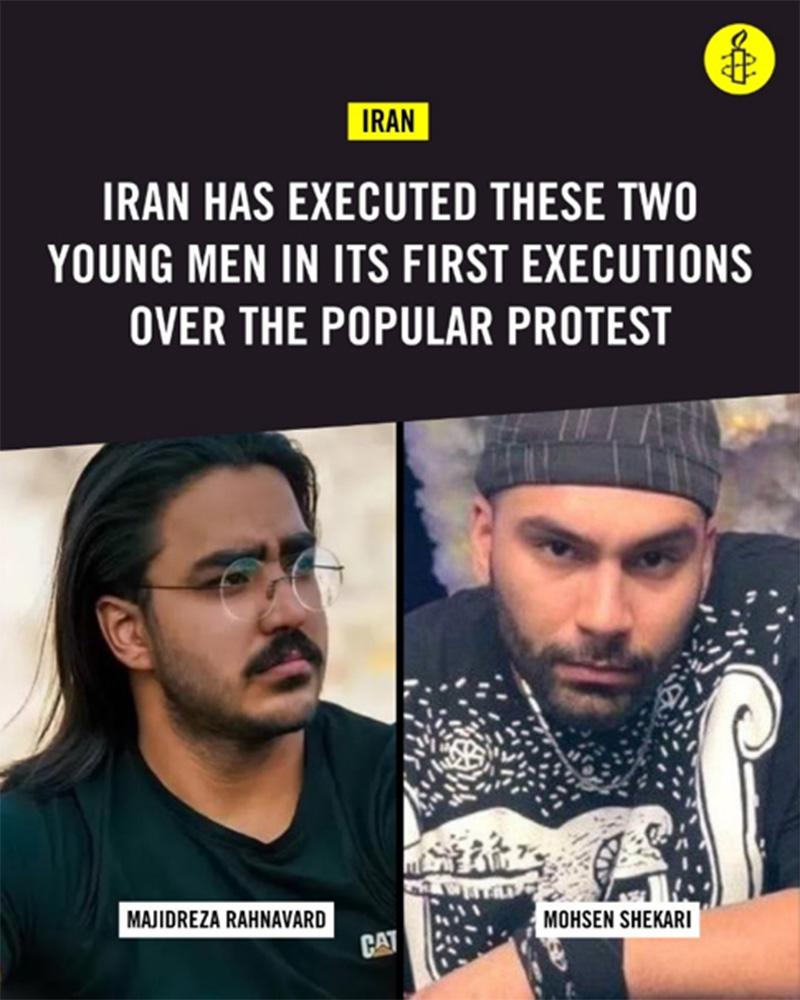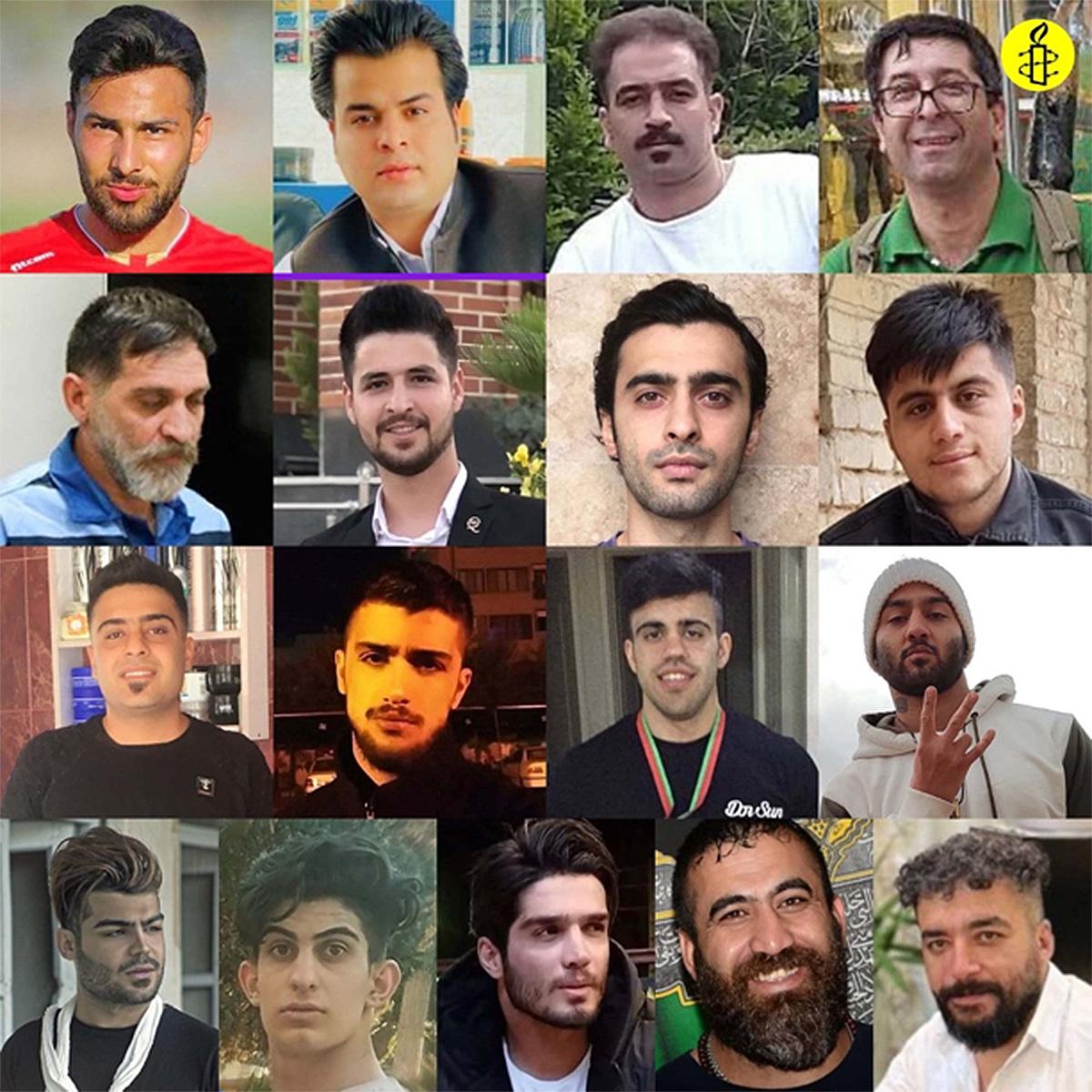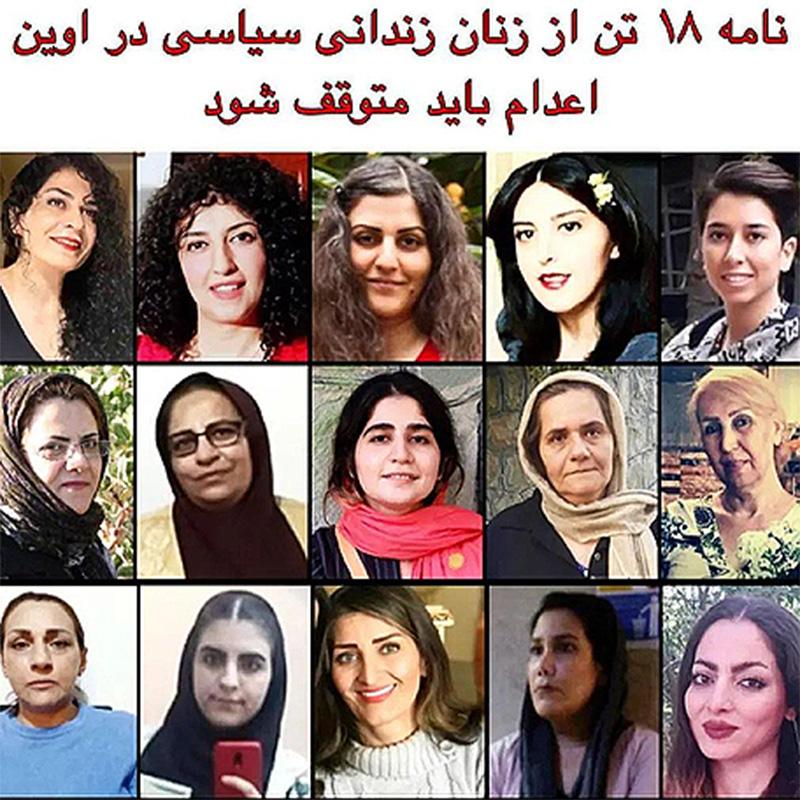BREAKING NEWS, Saturday December 17. As we go to press, there are reports that prisoners in Karaj Central Prison staged a protest against the executions taking place there. (Karaj is an industrial town outside Tehran which has been a hotbed of the uprising and home to many of those slated for execution.) In response, guards apparently fired on the prisoners, reportedly killing at least one.
An “informed source” told HRANA News: “Prison officials were transferring 4 prisoners sentenced to death to carry out their sentences, when they faced protests and shouting slogans from a number of prisoners located in halls 2, 3 and 5. The protest of the prisoners turned into a conflict and violence with the intervention of the guard, and more than 100 prisoners were injured. The prison guards resorted to shooting to suppress the protest… The prisoners broke a number of prison doors and cameras in protest against the violent behavior of the prison officials.”
At this writing, the regime is denying these reports and claims all prisoners are in good health. We will cover this significant development and responses to it as more information becomes available.
23 Days—That’s All It Took to Execute Majidreza Rahnavard
... [L]et us not give up, let us rise up to save the lives of those in prison and stop the cycle of state murder. To tear off the noose from around the necks of our youth and to tear down the high gallows of death, rise up.
—From letter from 18 women political prisoners being held at Evin Prison
Twenty-three days is all it took for the Islamic Republic of Iran (IRI) to arrest, torture, hold a sham “trial,” issue a conviction based on a forced confession, deny appeals, and then publicly hang 23-year-old protester Majidreza Rahnavard from a crane on December 12.
The state media shared a video “confession” of Majidreza, who was blindfolded, his arm in a sling, and surrounded by hooded guards in an attempt to terrorize Iran’s rebels. But Majidreza responded defiantly when asked his last will: “Don’t mourn at my grave. Don’t read the Quran. Don’t pray. Celebrate. Play joyful music.”
This one incident concentrates both sides of the intensifying conflict in Iran, an unprecedented and unabated uprising now entering its fourth month.
The Islamic Republic has fast-tracked dozens of protesters into its execution pipeline, unleashing brave and furious outrage both inside Iran and abroad. But to concretely create a situation where the regime is forced to step back, or to pay a huge political price for continuing to execute political prisoners, much broader, deeper, and more active outrage, protest and support for the courageous uprising in Iran is needed from the people—on many fronts—worldwide.
Here we are not talking about the hypocritical support of the rulers of the world’s predatory imperialist powers and institutions they dominate. We are talking about the need for masses of ordinary people, celebrities, writers, students and youth and many others to stand up boldly and insist that this will not be tolerated by decent people.
Repression Enters New Phase of Executions: “Good lesson in shortest possible time”
Two young protesters were hanged in just four days. In addition to Majidreza, Mohsen Shekari, a 23-year-old café worker, was hung on December 8. He’d been convicted on “waging war against God” after being forced to confess to blocking a Tehran street during a protest and wounding a member of the murderous Basij plainclothes paramilitary. The youths’ families were not alerted or allowed to bury their loved ones.

Mohsen Shekari, 23, and Majidreza Rahnavard, 23, executions by hanging for protesting in Iran. Graphic: Amnesty International
On November 6, Iranian lawmakers had voted overwhelmingly to ask state officials and Iran’s judiciary “to treat those who waged war [against the Islamic establishment] … in a way that would serve as a good lesson in the shortest possible time”.
One Parliamentarian complained that 23 days between arrest and execution was too long a delay. “The time between the arrest of rioters and their execution is too long. They should be executed within 5 or 10 days after arrest. I firmly support the performance of the judiciary regarding the recent events.”
At least 11 more men have been sentenced to death on charges of “waging war against God,” and at least 15 others are awaiting or undergoing trials on capital offenses.1
Among those who are being punished for using their well-known voices are rapper Toomaj Salehi (“Corruption on Earth”), rapper Saman Yasin (“Warring against God”), and soccer player Amir Nasr-Azadani (“Armed Rebellion”).
In every case, convictions followed sham trials without due process or legal representation of the defendant’s choice. Instead defendants have been “represented” by regime-assigned lawyers whose role is to facilitate conviction while giving an appearance of a “fair trial.” Some were group trials or lasted only a few minutes. Families were not allowed to be present.

Amnesty International composite of some of the prisoners convicted of, or charged with, crimes carrying the death penalty. [ L-R from top row: Amir Nasr-Azadani, Ebarhim Rigi, Saeed Yaghoubi, Hamid Ghare-Hassanlou; Manouchehr Mehman Navaz, Mohammad Ghobadlou , Hossein Mohammadi, Mahan Sadrat Madani, [Unknown], Mohammad Mehdi Karami, Sahand Nourmohammad-Zadeh, Toomaj Salehi, Saman Seydi (Yasin), Mohammad Boroughani, Sayed Mohammad Hosseini, Akbar Ghafari, Saleh Mirhashemi] Collage: Amnesty International
Lynching Committees Masquerading as Courts
“Lynching committees masquerading as courts are threatening people with death to instill fear in protesters and crush the country’s freedom movement,” said Hadi Ghaemi, executive director of the Center for Human Rights in Iran (CHRI). “Young men in their 20s are being hanged after show trials, and more are being sentenced each day in Iran…”2
Hideous examples of the Islamic Republic’s murderous barbarity abound. One protester on death row—Mehdi Karami, a 20-year-old karate champion—had a lawyer assigned to his case who won’t answer his family’s calls. “Every night I fear they will tell me the news of my child’s execution,” his father, a street vendor who sells napkins and tissues, said.
Radiologist Dr. Hamid Ghare-Hassanlou, who has built several schools in rural areas, and his wife happened on a protest in which a Basiji was killed. The next day, the security forces arrested and beat them. They’re accused of taking part in the killing and now Dr. Hassanlou is sentenced to death and his wife to 25 years with no contact or visitation rights.”3 Doctors and medical workers around the world have mobilized to stop the execution, including by making videos stating in several languages: “I am Dr. Hamid Ghare-Hassanlou,” such as this one from Stanford Medical.
Although official public hangings of protesters with a thin “legal” façade are a horrific tool, extralegal executions of protesters continue on a daily basis with fatal beatings, shootings and disappearances—495 deaths over the past three months according to HRANA's documented daily statistics, which don’t include disappearances or deaths of people whose family members are intimidated to not report them. Half of these deaths were in just three regions of oppressed minorities: Sistan/Baluchistan, Kurdistan, and West Azerbaijani.4
Also, at least 400 people have been sentenced to up to 10 years in prison for their involvement in anti-government protests, according to officials.5
“To tear off the noose from around the neck of our youth and to tear down the high gallows of death, rise up. There is no other way!”
“The public hangings have shaken Iran and sparked widespread fury that risks further fueling the unrest instead of containing it,” the New York Times reports. “Both executions [of Mohsen and Majidreza] spawned immediate and large street protests in the two men’s home neighborhoods. Demonstrators marched and chanted ‘with each person killed a thousand will rise up,’ and ‘those who are sitting, you will be next’…6
“Rise Up to Save the Lives of Those in Prison”
Eighteen women political prisoners in Evin Prison published a letter calling on people to rise up in the streets against death sentences and executions, announcing their plan to sit in December 12 at the office of the women's ward guard in Evin.
The statement reads, in part:
... [L]et us not give up, let us rise up to save the lives of those in prison and stop the cycle of state murder. To tear off the noose from around the necks of our youth and to tear down the high gallows of death, rise up.
There is no other way! This time, let’s occupy the streets of the city with the cry of “Stop the executions" and continue the strikes with greater power and inclusiveness.
Read the full statement and signers’ names, translated by IEC volunteers, here. For Farsi, see Narges Mohammadi's post or HRANA-news.
“Death to the Execution Republic”
The city of Zahedan in Sistan-Baluchistan has been the scene of horrific repression by the Islamic Republic, including the “Bloody Friday” massacre of at least 90 peaceful protesters on September 30. But people have continued to fight, with hundreds in the streets there and in other Baluchi cities this past Friday, December 16 which called for “Death to the Execution Republic” and “Death to the Child-Killing Regime.”
High School Student Sonia Sharifi Released After Outcry
A partial victory against the execution machine was won on December 15 when 17-year-old protester Sonia Sharifi, convicted of “waging war against God” and sentenced to death, was suddenly released on bail after a concerted global social media campaign. Just hours before, the high school student had been in imminent danger of execution after a confession forced by two months of torture in solitary. She celebrated her homecoming amid hundreds of honking car horns and joyful dancing in the streets.
Artists Protest in Tehran to Stop the Execution Machine
Artists have expressed their outrage in dramatic and musical performances.
“Performance by anonymous artists in Tehran: to stop the execution machine … Don't be silent, the only way to prevent the killing of our loved ones is going on the offensive. They must be forced to retreat, right now, and isolated. The way is widespread protests, wherever we are, we must protest against the resumption of executions.”
Global Protests Against Executions
As of December 11, thousands in tens of cities, in Germany, U.S., Italy, UK, Australia, Norway, and more, protested IRI’s executions. As of this writing, there are plans for December 17 mobilizations in dozens of cities focused on the executions.
